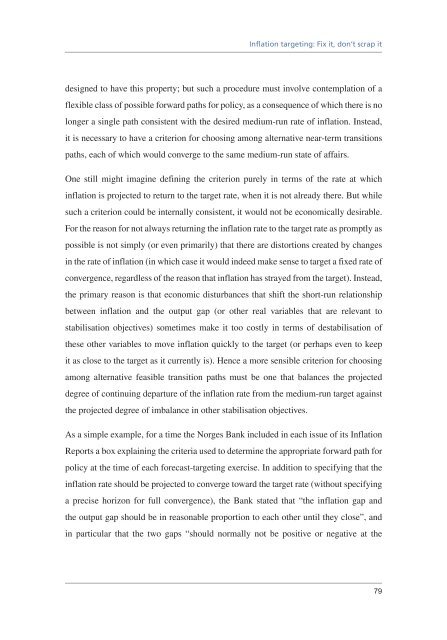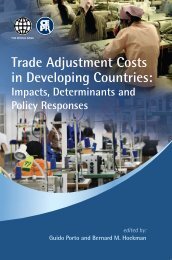Is inflation targeting dead? Central Banking After the Crisis - Vox
Is inflation targeting dead? Central Banking After the Crisis - Vox
Is inflation targeting dead? Central Banking After the Crisis - Vox
Create successful ePaper yourself
Turn your PDF publications into a flip-book with our unique Google optimized e-Paper software.
Inflation <strong>targeting</strong>: Fix it, don’t scrap itdesigned to have this property; but such a procedure must involve contemplation of aflexible class of possible forward paths for policy, as a consequence of which <strong>the</strong>re is nolonger a single path consistent with <strong>the</strong> desired medium-run rate of <strong>inflation</strong>. Instead,it is necessary to have a criterion for choosing among alternative near-term transitionspaths, each of which would converge to <strong>the</strong> same medium-run state of affairs.One still might imagine defining <strong>the</strong> criterion purely in terms of <strong>the</strong> rate at which<strong>inflation</strong> is projected to return to <strong>the</strong> target rate, when it is not already <strong>the</strong>re. But whilesuch a criterion could be internally consistent, it would not be economically desirable.For <strong>the</strong> reason for not always returning <strong>the</strong> <strong>inflation</strong> rate to <strong>the</strong> target rate as promptly aspossible is not simply (or even primarily) that <strong>the</strong>re are distortions created by changesin <strong>the</strong> rate of <strong>inflation</strong> (in which case it would indeed make sense to target a fixed rate ofconvergence, regardless of <strong>the</strong> reason that <strong>inflation</strong> has strayed from <strong>the</strong> target). Instead,<strong>the</strong> primary reason is that economic disturbances that shift <strong>the</strong> short-run relationshipbetween <strong>inflation</strong> and <strong>the</strong> output gap (or o<strong>the</strong>r real variables that are relevant tostabilisation objectives) sometimes make it too costly in terms of destabilisation of<strong>the</strong>se o<strong>the</strong>r variables to move <strong>inflation</strong> quickly to <strong>the</strong> target (or perhaps even to keepit as close to <strong>the</strong> target as it currently is). Hence a more sensible criterion for choosingamong alternative feasible transition paths must be one that balances <strong>the</strong> projecteddegree of continuing departure of <strong>the</strong> <strong>inflation</strong> rate from <strong>the</strong> medium-run target against<strong>the</strong> projected degree of imbalance in o<strong>the</strong>r stabilisation objectives.As a simple example, for a time <strong>the</strong> Norges Bank included in each issue of its InflationReports a box explaining <strong>the</strong> criteria used to determine <strong>the</strong> appropriate forward path forpolicy at <strong>the</strong> time of each forecast-<strong>targeting</strong> exercise. In addition to specifying that <strong>the</strong><strong>inflation</strong> rate should be projected to converge toward <strong>the</strong> target rate (without specifyinga precise horizon for full convergence), <strong>the</strong> Bank stated that “<strong>the</strong> <strong>inflation</strong> gap and<strong>the</strong> output gap should be in reasonable proportion to each o<strong>the</strong>r until <strong>the</strong>y close”, andin particular that <strong>the</strong> two gaps “should normally not be positive or negative at <strong>the</strong>79














